Psychosocial Theories and Their Application: Leah's Case Study
VerifiedAdded on 2021/05/31
|8
|2046
|121
Essay
AI Summary
This essay delves into psychosocial theories, including Erikson's psychosocial theory, psychodynamic theory, and systems theory, and their application in understanding human behavior. The paper uses a case study of a woman named Leah to illustrate the practical application of these theories in social work. It examines how these theories can be used to analyze a client's behavior, develop treatment plans, and address various issues, such as relationship problems, emotional outbursts, and self-isolation. The analysis covers the influence of social environments, internal psychological processes, and external factors on individual behavior. The essay also highlights the role of social workers in assessing clients' needs, providing support, and facilitating positive change. The case study demonstrates how a worker can understand the client's background, choices, and actions within the context of these theories, which in turn informs the treatment plan. The paper concludes by reiterating the importance of these theories in social work practice to help clients effectively.
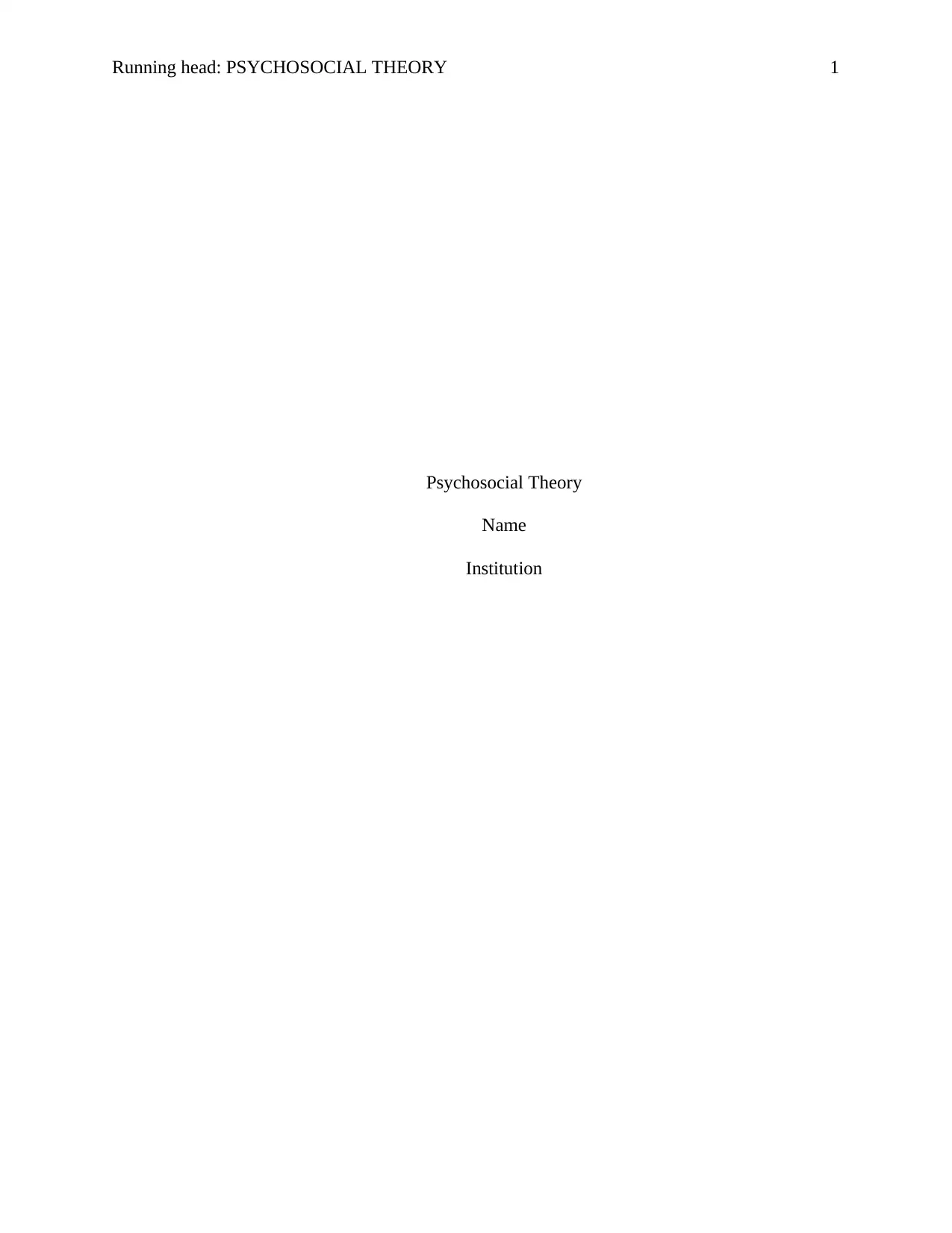
Running head: PSYCHOSOCIAL THEORY 1
Psychosocial Theory
Name
Institution
Psychosocial Theory
Name
Institution
Paraphrase This Document
Need a fresh take? Get an instant paraphrase of this document with our AI Paraphraser
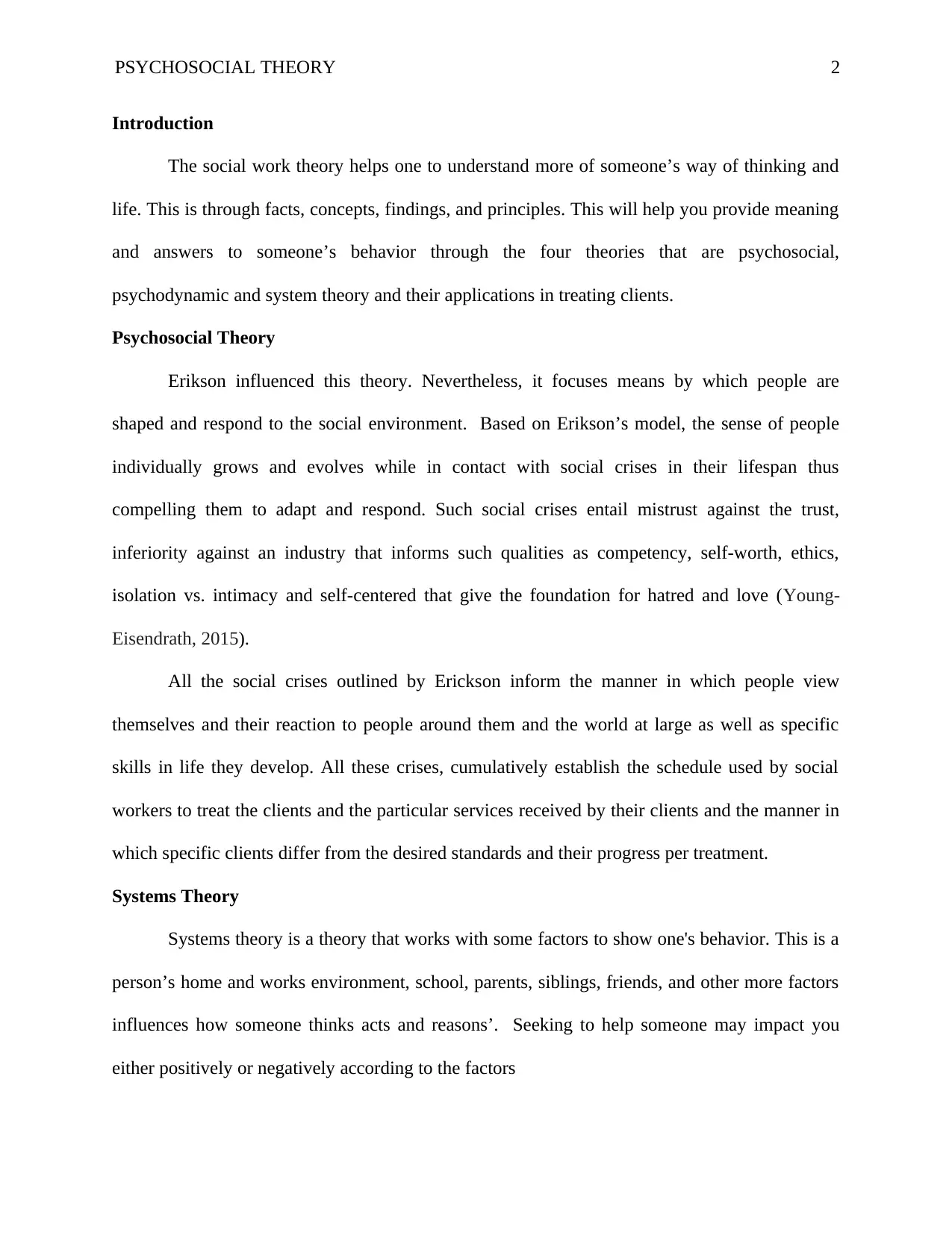
PSYCHOSOCIAL THEORY 2
Introduction
The social work theory helps one to understand more of someone’s way of thinking and
life. This is through facts, concepts, findings, and principles. This will help you provide meaning
and answers to someone’s behavior through the four theories that are psychosocial,
psychodynamic and system theory and their applications in treating clients.
Psychosocial Theory
Erikson influenced this theory. Nevertheless, it focuses means by which people are
shaped and respond to the social environment. Based on Erikson’s model, the sense of people
individually grows and evolves while in contact with social crises in their lifespan thus
compelling them to adapt and respond. Such social crises entail mistrust against the trust,
inferiority against an industry that informs such qualities as competency, self-worth, ethics,
isolation vs. intimacy and self-centered that give the foundation for hatred and love (Young-
Eisendrath, 2015).
All the social crises outlined by Erickson inform the manner in which people view
themselves and their reaction to people around them and the world at large as well as specific
skills in life they develop. All these crises, cumulatively establish the schedule used by social
workers to treat the clients and the particular services received by their clients and the manner in
which specific clients differ from the desired standards and their progress per treatment.
Systems Theory
Systems theory is a theory that works with some factors to show one's behavior. This is a
person’s home and works environment, school, parents, siblings, friends, and other more factors
influences how someone thinks acts and reasons’. Seeking to help someone may impact you
either positively or negatively according to the factors
Introduction
The social work theory helps one to understand more of someone’s way of thinking and
life. This is through facts, concepts, findings, and principles. This will help you provide meaning
and answers to someone’s behavior through the four theories that are psychosocial,
psychodynamic and system theory and their applications in treating clients.
Psychosocial Theory
Erikson influenced this theory. Nevertheless, it focuses means by which people are
shaped and respond to the social environment. Based on Erikson’s model, the sense of people
individually grows and evolves while in contact with social crises in their lifespan thus
compelling them to adapt and respond. Such social crises entail mistrust against the trust,
inferiority against an industry that informs such qualities as competency, self-worth, ethics,
isolation vs. intimacy and self-centered that give the foundation for hatred and love (Young-
Eisendrath, 2015).
All the social crises outlined by Erickson inform the manner in which people view
themselves and their reaction to people around them and the world at large as well as specific
skills in life they develop. All these crises, cumulatively establish the schedule used by social
workers to treat the clients and the particular services received by their clients and the manner in
which specific clients differ from the desired standards and their progress per treatment.
Systems Theory
Systems theory is a theory that works with some factors to show one's behavior. This is a
person’s home and works environment, school, parents, siblings, friends, and other more factors
influences how someone thinks acts and reasons’. Seeking to help someone may impact you
either positively or negatively according to the factors
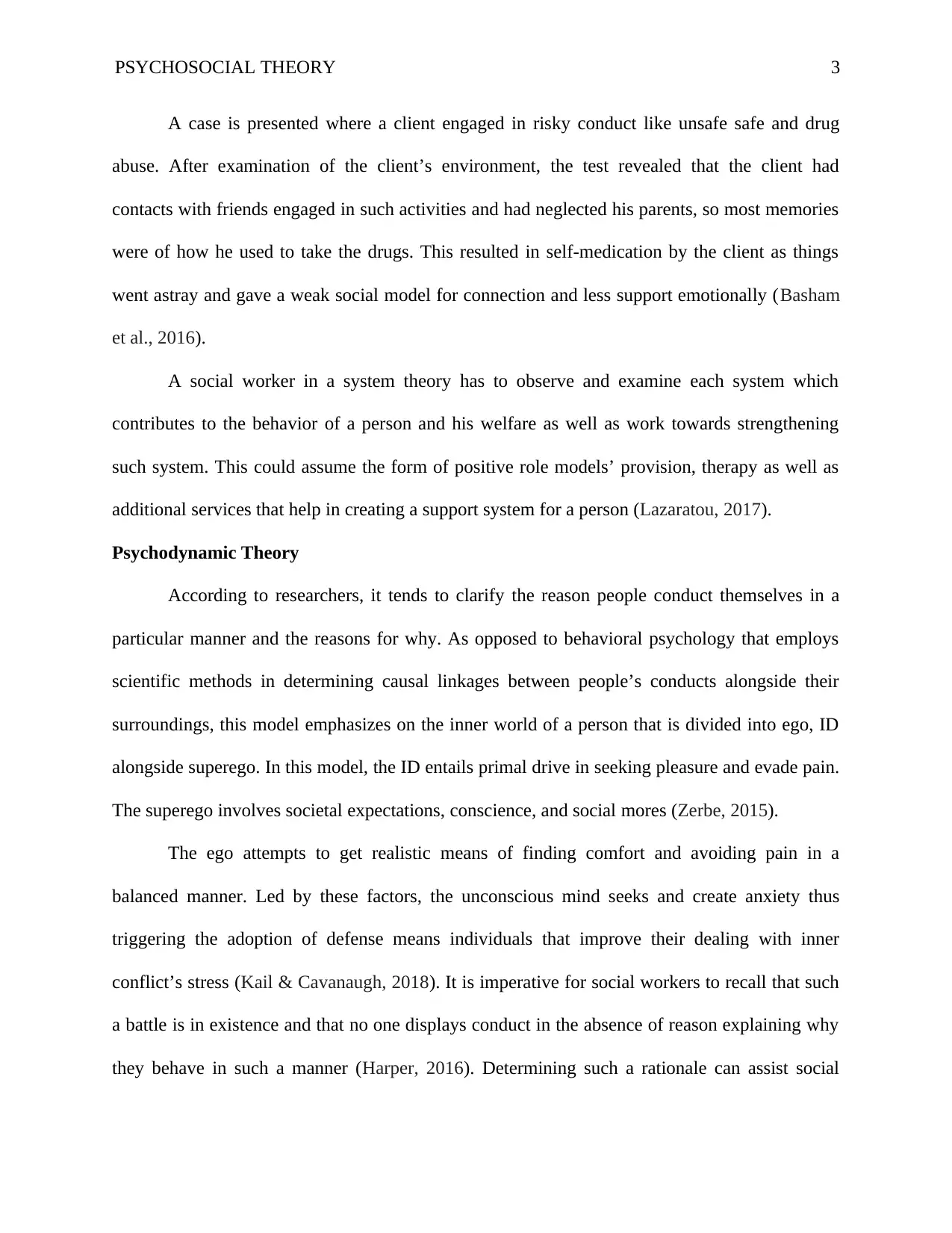
PSYCHOSOCIAL THEORY 3
A case is presented where a client engaged in risky conduct like unsafe safe and drug
abuse. After examination of the client’s environment, the test revealed that the client had
contacts with friends engaged in such activities and had neglected his parents, so most memories
were of how he used to take the drugs. This resulted in self-medication by the client as things
went astray and gave a weak social model for connection and less support emotionally (Basham
et al., 2016).
A social worker in a system theory has to observe and examine each system which
contributes to the behavior of a person and his welfare as well as work towards strengthening
such system. This could assume the form of positive role models’ provision, therapy as well as
additional services that help in creating a support system for a person (Lazaratou, 2017).
Psychodynamic Theory
According to researchers, it tends to clarify the reason people conduct themselves in a
particular manner and the reasons for why. As opposed to behavioral psychology that employs
scientific methods in determining causal linkages between people’s conducts alongside their
surroundings, this model emphasizes on the inner world of a person that is divided into ego, ID
alongside superego. In this model, the ID entails primal drive in seeking pleasure and evade pain.
The superego involves societal expectations, conscience, and social mores (Zerbe, 2015).
The ego attempts to get realistic means of finding comfort and avoiding pain in a
balanced manner. Led by these factors, the unconscious mind seeks and create anxiety thus
triggering the adoption of defense means individuals that improve their dealing with inner
conflict’s stress (Kail & Cavanaugh, 2018). It is imperative for social workers to recall that such
a battle is in existence and that no one displays conduct in the absence of reason explaining why
they behave in such a manner (Harper, 2016). Determining such a rationale can assist social
A case is presented where a client engaged in risky conduct like unsafe safe and drug
abuse. After examination of the client’s environment, the test revealed that the client had
contacts with friends engaged in such activities and had neglected his parents, so most memories
were of how he used to take the drugs. This resulted in self-medication by the client as things
went astray and gave a weak social model for connection and less support emotionally (Basham
et al., 2016).
A social worker in a system theory has to observe and examine each system which
contributes to the behavior of a person and his welfare as well as work towards strengthening
such system. This could assume the form of positive role models’ provision, therapy as well as
additional services that help in creating a support system for a person (Lazaratou, 2017).
Psychodynamic Theory
According to researchers, it tends to clarify the reason people conduct themselves in a
particular manner and the reasons for why. As opposed to behavioral psychology that employs
scientific methods in determining causal linkages between people’s conducts alongside their
surroundings, this model emphasizes on the inner world of a person that is divided into ego, ID
alongside superego. In this model, the ID entails primal drive in seeking pleasure and evade pain.
The superego involves societal expectations, conscience, and social mores (Zerbe, 2015).
The ego attempts to get realistic means of finding comfort and avoiding pain in a
balanced manner. Led by these factors, the unconscious mind seeks and create anxiety thus
triggering the adoption of defense means individuals that improve their dealing with inner
conflict’s stress (Kail & Cavanaugh, 2018). It is imperative for social workers to recall that such
a battle is in existence and that no one displays conduct in the absence of reason explaining why
they behave in such a manner (Harper, 2016). Determining such a rationale can assist social
⊘ This is a preview!⊘
Do you want full access?
Subscribe today to unlock all pages.

Trusted by 1+ million students worldwide
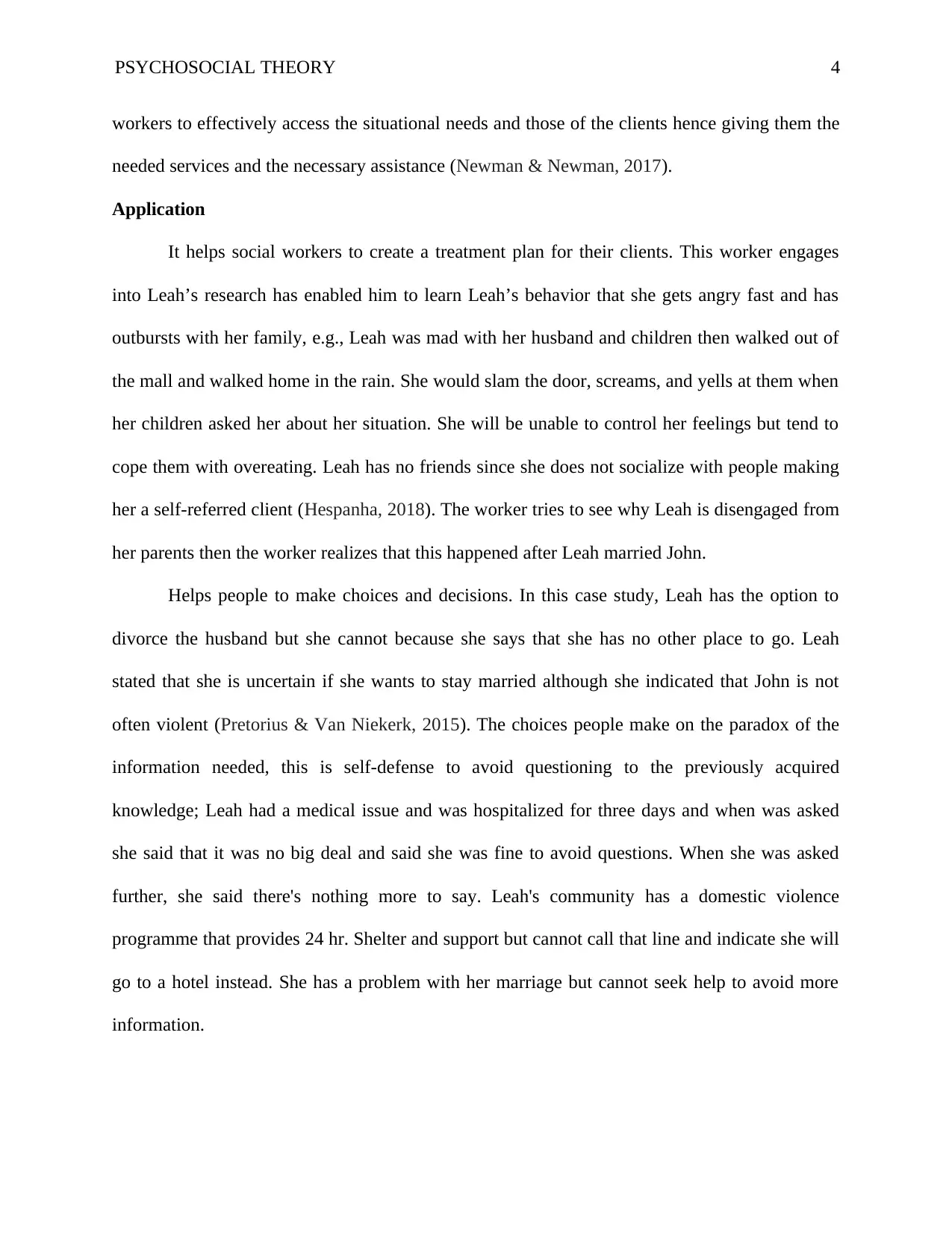
PSYCHOSOCIAL THEORY 4
workers to effectively access the situational needs and those of the clients hence giving them the
needed services and the necessary assistance (Newman & Newman, 2017).
Application
It helps social workers to create a treatment plan for their clients. This worker engages
into Leah’s research has enabled him to learn Leah’s behavior that she gets angry fast and has
outbursts with her family, e.g., Leah was mad with her husband and children then walked out of
the mall and walked home in the rain. She would slam the door, screams, and yells at them when
her children asked her about her situation. She will be unable to control her feelings but tend to
cope them with overeating. Leah has no friends since she does not socialize with people making
her a self-referred client (Hespanha, 2018). The worker tries to see why Leah is disengaged from
her parents then the worker realizes that this happened after Leah married John.
Helps people to make choices and decisions. In this case study, Leah has the option to
divorce the husband but she cannot because she says that she has no other place to go. Leah
stated that she is uncertain if she wants to stay married although she indicated that John is not
often violent (Pretorius & Van Niekerk, 2015). The choices people make on the paradox of the
information needed, this is self-defense to avoid questioning to the previously acquired
knowledge; Leah had a medical issue and was hospitalized for three days and when was asked
she said that it was no big deal and said she was fine to avoid questions. When she was asked
further, she said there's nothing more to say. Leah's community has a domestic violence
programme that provides 24 hr. Shelter and support but cannot call that line and indicate she will
go to a hotel instead. She has a problem with her marriage but cannot seek help to avoid more
information.
workers to effectively access the situational needs and those of the clients hence giving them the
needed services and the necessary assistance (Newman & Newman, 2017).
Application
It helps social workers to create a treatment plan for their clients. This worker engages
into Leah’s research has enabled him to learn Leah’s behavior that she gets angry fast and has
outbursts with her family, e.g., Leah was mad with her husband and children then walked out of
the mall and walked home in the rain. She would slam the door, screams, and yells at them when
her children asked her about her situation. She will be unable to control her feelings but tend to
cope them with overeating. Leah has no friends since she does not socialize with people making
her a self-referred client (Hespanha, 2018). The worker tries to see why Leah is disengaged from
her parents then the worker realizes that this happened after Leah married John.
Helps people to make choices and decisions. In this case study, Leah has the option to
divorce the husband but she cannot because she says that she has no other place to go. Leah
stated that she is uncertain if she wants to stay married although she indicated that John is not
often violent (Pretorius & Van Niekerk, 2015). The choices people make on the paradox of the
information needed, this is self-defense to avoid questioning to the previously acquired
knowledge; Leah had a medical issue and was hospitalized for three days and when was asked
she said that it was no big deal and said she was fine to avoid questions. When she was asked
further, she said there's nothing more to say. Leah's community has a domestic violence
programme that provides 24 hr. Shelter and support but cannot call that line and indicate she will
go to a hotel instead. She has a problem with her marriage but cannot seek help to avoid more
information.
Paraphrase This Document
Need a fresh take? Get an instant paraphrase of this document with our AI Paraphraser
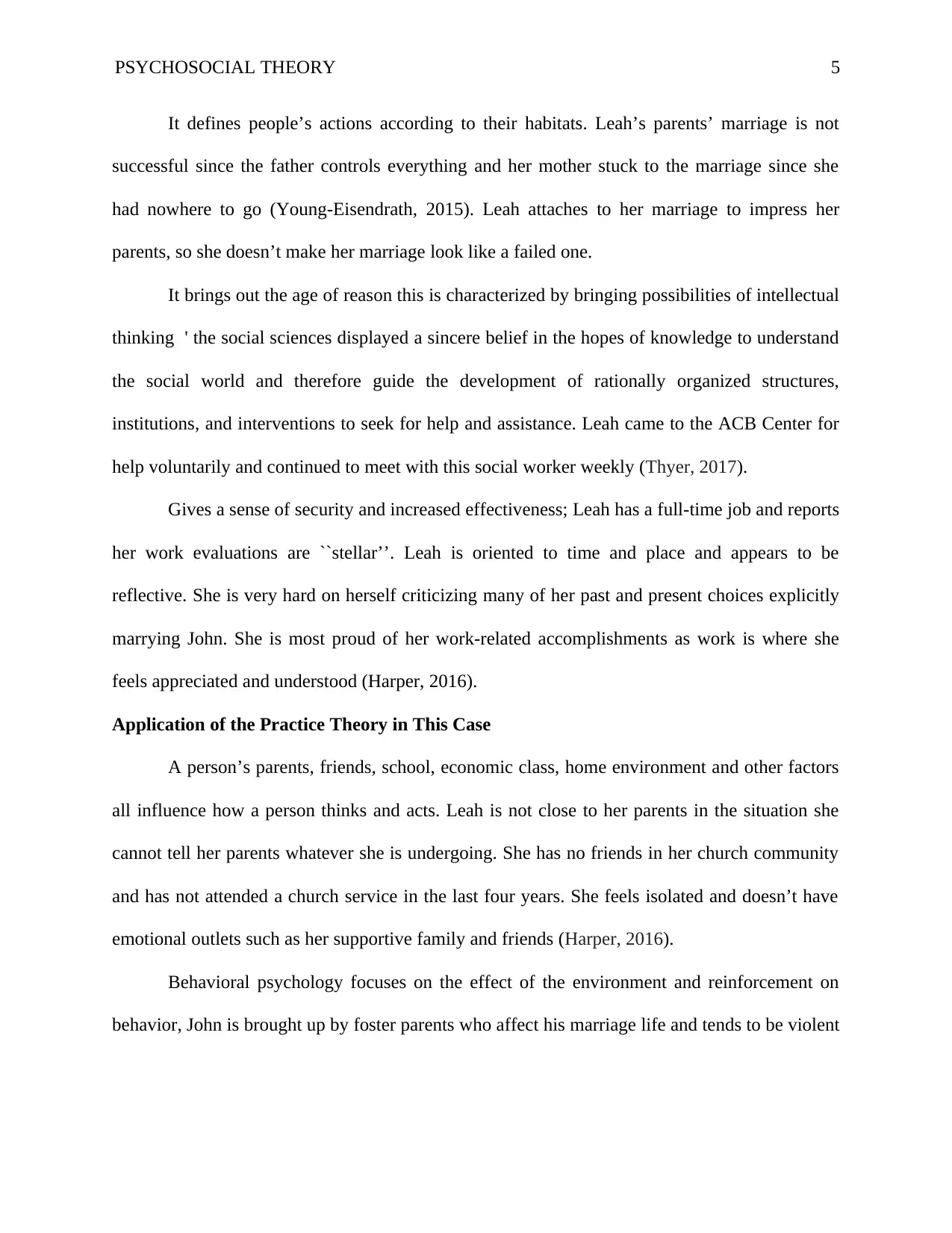
PSYCHOSOCIAL THEORY 5
It defines people’s actions according to their habitats. Leah’s parents’ marriage is not
successful since the father controls everything and her mother stuck to the marriage since she
had nowhere to go (Young-Eisendrath, 2015). Leah attaches to her marriage to impress her
parents, so she doesn’t make her marriage look like a failed one.
It brings out the age of reason this is characterized by bringing possibilities of intellectual
thinking ' the social sciences displayed a sincere belief in the hopes of knowledge to understand
the social world and therefore guide the development of rationally organized structures,
institutions, and interventions to seek for help and assistance. Leah came to the ACB Center for
help voluntarily and continued to meet with this social worker weekly (Thyer, 2017).
Gives a sense of security and increased effectiveness; Leah has a full-time job and reports
her work evaluations are ``stellar’’. Leah is oriented to time and place and appears to be
reflective. She is very hard on herself criticizing many of her past and present choices explicitly
marrying John. She is most proud of her work-related accomplishments as work is where she
feels appreciated and understood (Harper, 2016).
Application of the Practice Theory in This Case
A person’s parents, friends, school, economic class, home environment and other factors
all influence how a person thinks and acts. Leah is not close to her parents in the situation she
cannot tell her parents whatever she is undergoing. She has no friends in her church community
and has not attended a church service in the last four years. She feels isolated and doesn’t have
emotional outlets such as her supportive family and friends (Harper, 2016).
Behavioral psychology focuses on the effect of the environment and reinforcement on
behavior, John is brought up by foster parents who affect his marriage life and tends to be violent
It defines people’s actions according to their habitats. Leah’s parents’ marriage is not
successful since the father controls everything and her mother stuck to the marriage since she
had nowhere to go (Young-Eisendrath, 2015). Leah attaches to her marriage to impress her
parents, so she doesn’t make her marriage look like a failed one.
It brings out the age of reason this is characterized by bringing possibilities of intellectual
thinking ' the social sciences displayed a sincere belief in the hopes of knowledge to understand
the social world and therefore guide the development of rationally organized structures,
institutions, and interventions to seek for help and assistance. Leah came to the ACB Center for
help voluntarily and continued to meet with this social worker weekly (Thyer, 2017).
Gives a sense of security and increased effectiveness; Leah has a full-time job and reports
her work evaluations are ``stellar’’. Leah is oriented to time and place and appears to be
reflective. She is very hard on herself criticizing many of her past and present choices explicitly
marrying John. She is most proud of her work-related accomplishments as work is where she
feels appreciated and understood (Harper, 2016).
Application of the Practice Theory in This Case
A person’s parents, friends, school, economic class, home environment and other factors
all influence how a person thinks and acts. Leah is not close to her parents in the situation she
cannot tell her parents whatever she is undergoing. She has no friends in her church community
and has not attended a church service in the last four years. She feels isolated and doesn’t have
emotional outlets such as her supportive family and friends (Harper, 2016).
Behavioral psychology focuses on the effect of the environment and reinforcement on
behavior, John is brought up by foster parents who affect his marriage life and tends to be violent
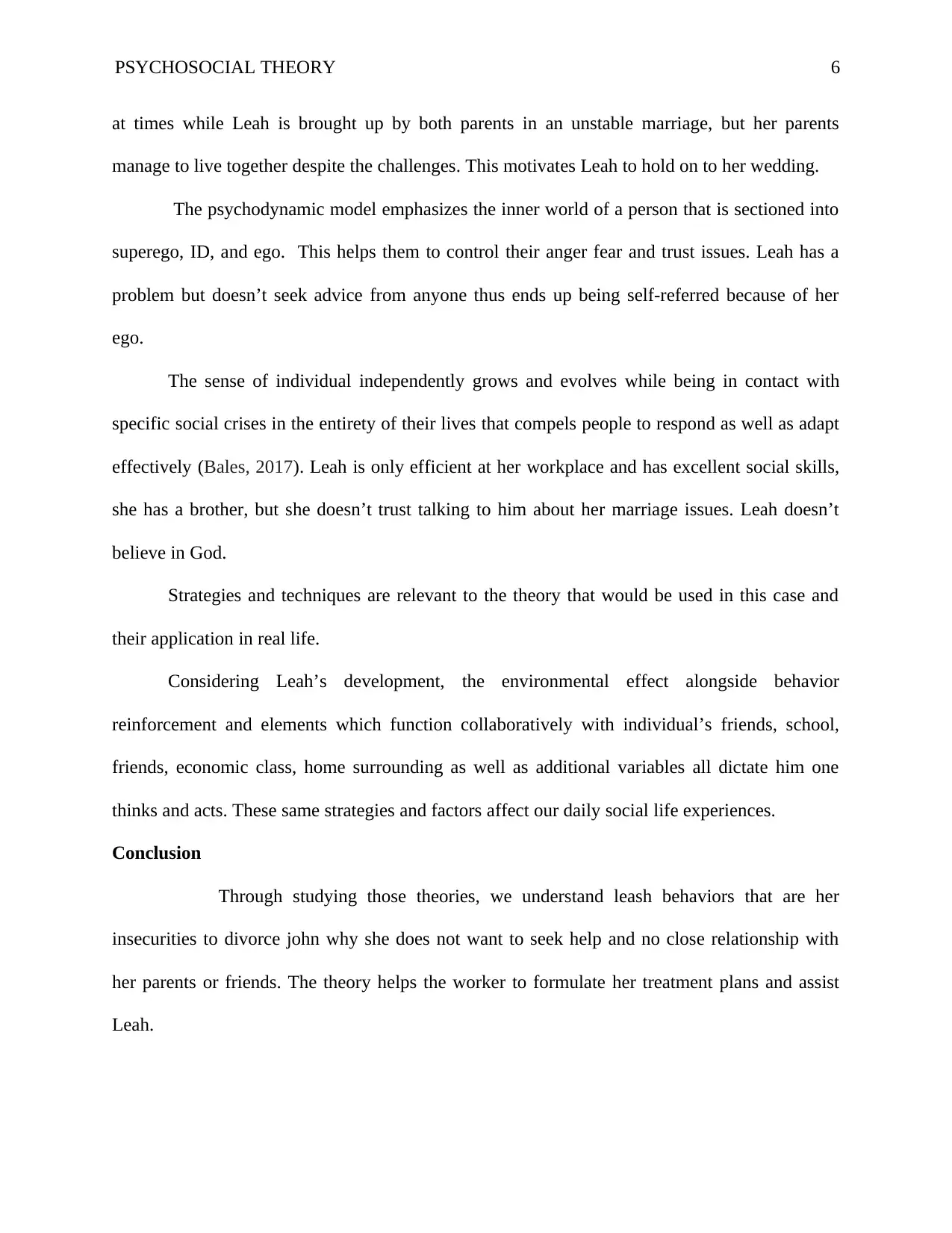
PSYCHOSOCIAL THEORY 6
at times while Leah is brought up by both parents in an unstable marriage, but her parents
manage to live together despite the challenges. This motivates Leah to hold on to her wedding.
The psychodynamic model emphasizes the inner world of a person that is sectioned into
superego, ID, and ego. This helps them to control their anger fear and trust issues. Leah has a
problem but doesn’t seek advice from anyone thus ends up being self-referred because of her
ego.
The sense of individual independently grows and evolves while being in contact with
specific social crises in the entirety of their lives that compels people to respond as well as adapt
effectively (Bales, 2017). Leah is only efficient at her workplace and has excellent social skills,
she has a brother, but she doesn’t trust talking to him about her marriage issues. Leah doesn’t
believe in God.
Strategies and techniques are relevant to the theory that would be used in this case and
their application in real life.
Considering Leah’s development, the environmental effect alongside behavior
reinforcement and elements which function collaboratively with individual’s friends, school,
friends, economic class, home surrounding as well as additional variables all dictate him one
thinks and acts. These same strategies and factors affect our daily social life experiences.
Conclusion
Through studying those theories, we understand leash behaviors that are her
insecurities to divorce john why she does not want to seek help and no close relationship with
her parents or friends. The theory helps the worker to formulate her treatment plans and assist
Leah.
at times while Leah is brought up by both parents in an unstable marriage, but her parents
manage to live together despite the challenges. This motivates Leah to hold on to her wedding.
The psychodynamic model emphasizes the inner world of a person that is sectioned into
superego, ID, and ego. This helps them to control their anger fear and trust issues. Leah has a
problem but doesn’t seek advice from anyone thus ends up being self-referred because of her
ego.
The sense of individual independently grows and evolves while being in contact with
specific social crises in the entirety of their lives that compels people to respond as well as adapt
effectively (Bales, 2017). Leah is only efficient at her workplace and has excellent social skills,
she has a brother, but she doesn’t trust talking to him about her marriage issues. Leah doesn’t
believe in God.
Strategies and techniques are relevant to the theory that would be used in this case and
their application in real life.
Considering Leah’s development, the environmental effect alongside behavior
reinforcement and elements which function collaboratively with individual’s friends, school,
friends, economic class, home surrounding as well as additional variables all dictate him one
thinks and acts. These same strategies and factors affect our daily social life experiences.
Conclusion
Through studying those theories, we understand leash behaviors that are her
insecurities to divorce john why she does not want to seek help and no close relationship with
her parents or friends. The theory helps the worker to formulate her treatment plans and assist
Leah.
⊘ This is a preview!⊘
Do you want full access?
Subscribe today to unlock all pages.

Trusted by 1+ million students worldwide
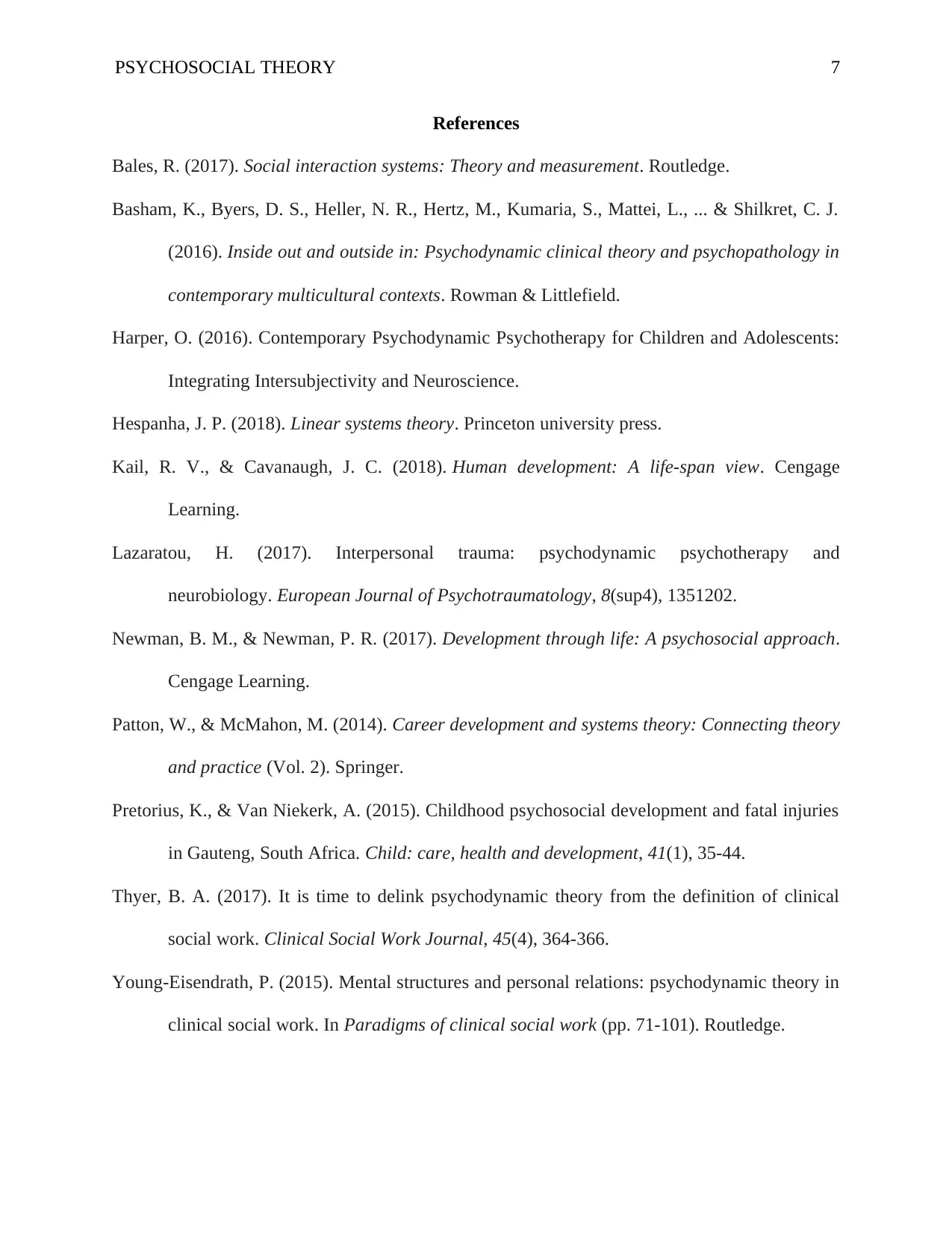
PSYCHOSOCIAL THEORY 7
References
Bales, R. (2017). Social interaction systems: Theory and measurement. Routledge.
Basham, K., Byers, D. S., Heller, N. R., Hertz, M., Kumaria, S., Mattei, L., ... & Shilkret, C. J.
(2016). Inside out and outside in: Psychodynamic clinical theory and psychopathology in
contemporary multicultural contexts. Rowman & Littlefield.
Harper, O. (2016). Contemporary Psychodynamic Psychotherapy for Children and Adolescents:
Integrating Intersubjectivity and Neuroscience.
Hespanha, J. P. (2018). Linear systems theory. Princeton university press.
Kail, R. V., & Cavanaugh, J. C. (2018). Human development: A life-span view. Cengage
Learning.
Lazaratou, H. (2017). Interpersonal trauma: psychodynamic psychotherapy and
neurobiology. European Journal of Psychotraumatology, 8(sup4), 1351202.
Newman, B. M., & Newman, P. R. (2017). Development through life: A psychosocial approach.
Cengage Learning.
Patton, W., & McMahon, M. (2014). Career development and systems theory: Connecting theory
and practice (Vol. 2). Springer.
Pretorius, K., & Van Niekerk, A. (2015). Childhood psychosocial development and fatal injuries
in Gauteng, South Africa. Child: care, health and development, 41(1), 35-44.
Thyer, B. A. (2017). It is time to delink psychodynamic theory from the definition of clinical
social work. Clinical Social Work Journal, 45(4), 364-366.
Young-Eisendrath, P. (2015). Mental structures and personal relations: psychodynamic theory in
clinical social work. In Paradigms of clinical social work (pp. 71-101). Routledge.
References
Bales, R. (2017). Social interaction systems: Theory and measurement. Routledge.
Basham, K., Byers, D. S., Heller, N. R., Hertz, M., Kumaria, S., Mattei, L., ... & Shilkret, C. J.
(2016). Inside out and outside in: Psychodynamic clinical theory and psychopathology in
contemporary multicultural contexts. Rowman & Littlefield.
Harper, O. (2016). Contemporary Psychodynamic Psychotherapy for Children and Adolescents:
Integrating Intersubjectivity and Neuroscience.
Hespanha, J. P. (2018). Linear systems theory. Princeton university press.
Kail, R. V., & Cavanaugh, J. C. (2018). Human development: A life-span view. Cengage
Learning.
Lazaratou, H. (2017). Interpersonal trauma: psychodynamic psychotherapy and
neurobiology. European Journal of Psychotraumatology, 8(sup4), 1351202.
Newman, B. M., & Newman, P. R. (2017). Development through life: A psychosocial approach.
Cengage Learning.
Patton, W., & McMahon, M. (2014). Career development and systems theory: Connecting theory
and practice (Vol. 2). Springer.
Pretorius, K., & Van Niekerk, A. (2015). Childhood psychosocial development and fatal injuries
in Gauteng, South Africa. Child: care, health and development, 41(1), 35-44.
Thyer, B. A. (2017). It is time to delink psychodynamic theory from the definition of clinical
social work. Clinical Social Work Journal, 45(4), 364-366.
Young-Eisendrath, P. (2015). Mental structures and personal relations: psychodynamic theory in
clinical social work. In Paradigms of clinical social work (pp. 71-101). Routledge.
Paraphrase This Document
Need a fresh take? Get an instant paraphrase of this document with our AI Paraphraser
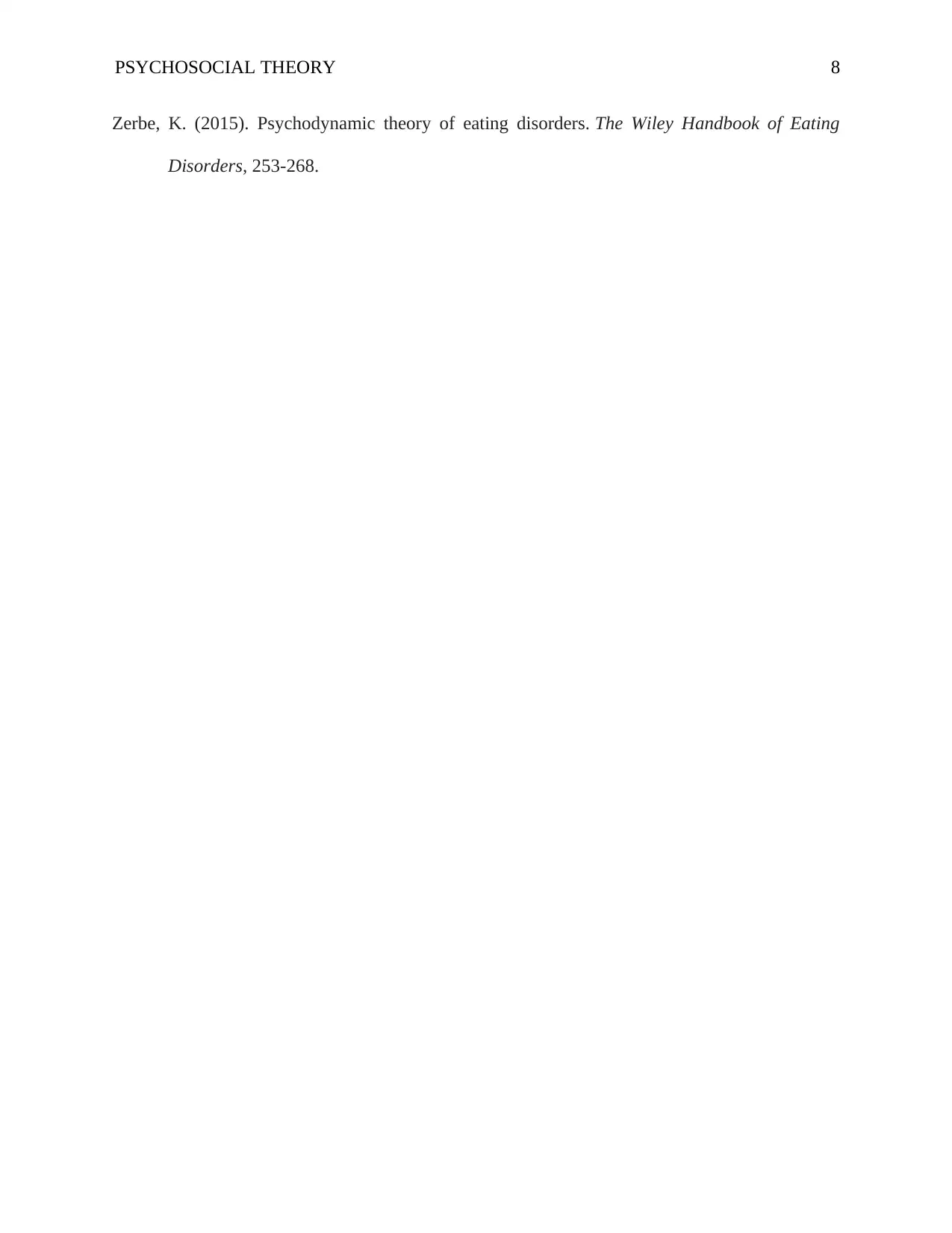
PSYCHOSOCIAL THEORY 8
Zerbe, K. (2015). Psychodynamic theory of eating disorders. The Wiley Handbook of Eating
Disorders, 253-268.
Zerbe, K. (2015). Psychodynamic theory of eating disorders. The Wiley Handbook of Eating
Disorders, 253-268.
1 out of 8
Your All-in-One AI-Powered Toolkit for Academic Success.
+13062052269
info@desklib.com
Available 24*7 on WhatsApp / Email
![[object Object]](/_next/static/media/star-bottom.7253800d.svg)
Unlock your academic potential
Copyright © 2020–2025 A2Z Services. All Rights Reserved. Developed and managed by ZUCOL.

